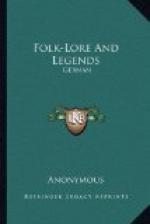A story is told of a boat’s crew who landed for the purpose of attacking the seals lying in the hollows of the crags at one of the stacks. The men stunned a number of the animals, and while they were in this state stripped them of their skins, with the fat attached to them. Leaving the carcasses on the rock, the crew were about to set off for the shore of Papa Stour, when such a tremendous swell arose that every one flew quickly to the boat. All succeeded in entering it except one man, who had imprudently lingered behind. The crew were unwilling to leave a companion to perish on the skerries, but the surge increased so fast, that after many unsuccessful attempts to bring the boat close in to the stack the unfortunate wight was left to his fate. A stormy night came on, and the deserted Shetlander saw no prospect before him but that of perishing from cold and hunger, or of being washed into the sea by the breakers which threatened to dash over the rocks. At length, he perceived many of the seals, who, in their flight had escaped the attack of the boatmen, approach the skerry, disrobe themselves of their amphibious hides, and resume the shape of the sons and daughters of the ocean. Their first object was to assist in the recovery of their friends, who having been stunned by clubs, had, while in that state, been deprived of their skins. When the flayed animals had regained their sensibility, they assumed their proper form of mermen or merwomen, and began to lament in a mournful lay, wildly accompanied by the storm that was raging around, the loss of their sea-dress, which would prevent them from again enjoying their native azure atmosphere, and coral mansions that lay below the deep waters of the Atlantic. But their chief lamentation was for Ollavitinus, the son of Gioga, who, having been stripped of his seal’s skin, would be for ever parted from his mates, and condemned to become an outcast inhabitant of the upper world. Their song was at length broken off, by observing one of their enemies viewing, with shivering limbs and looks of comfortless despair, the wild waves that dashed over the stack. Gioga immediately conceived the idea of rendering subservient to the advantage of the son the perilous situation of the man. She




